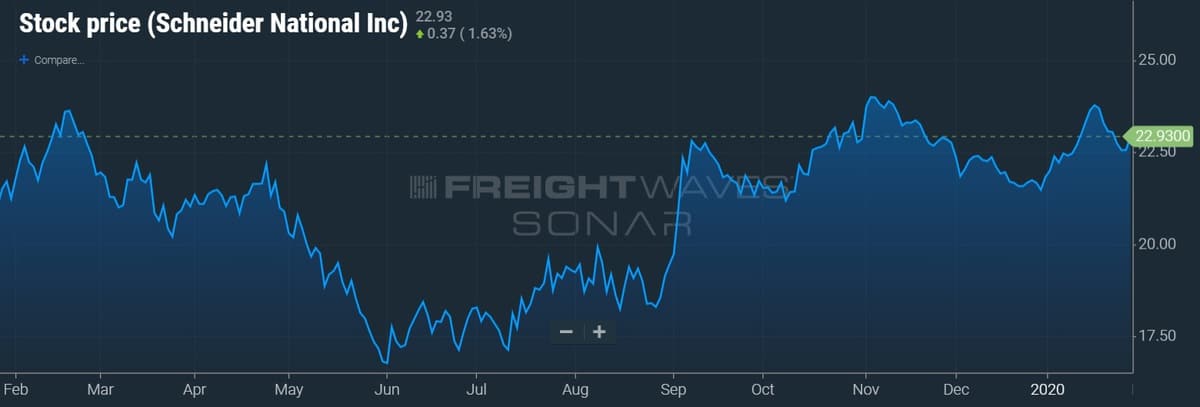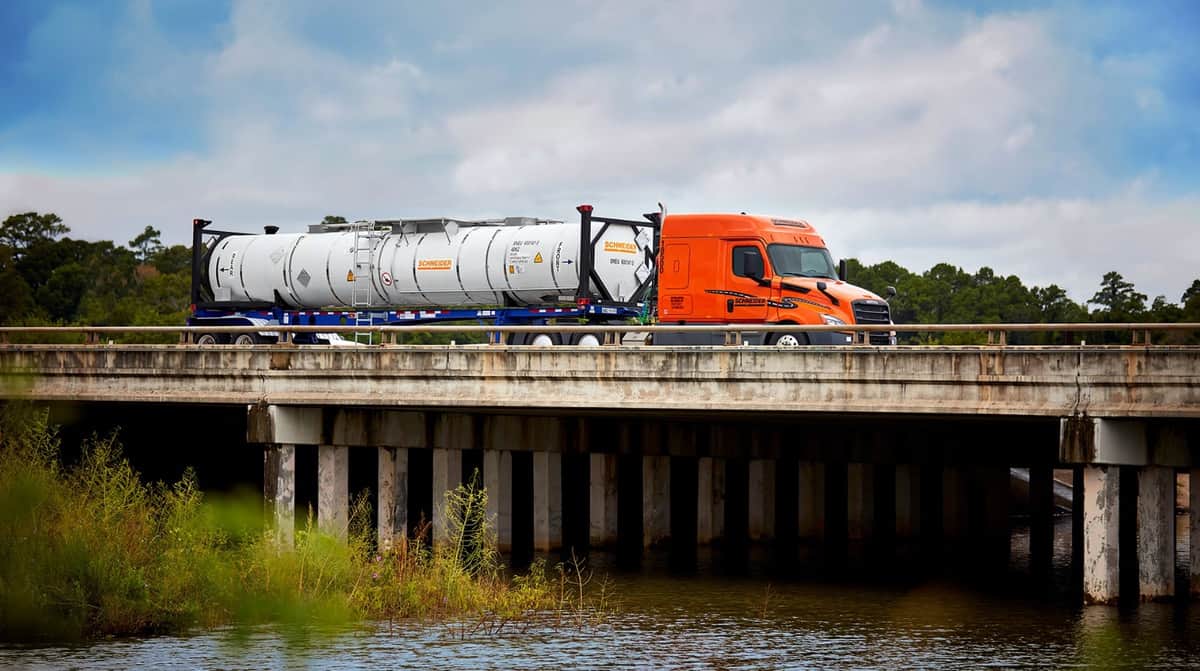Schneider National (NYSE: SNDR) reported adjusted fourth-quarter 2019 earnings per share (EPS) of $0.37, 25% lower year-over-year and 2 cents shy of analysts’ estimates. However, the 2020 outlook was in line with consensus expectations and management said that it would look to meaningfully deploy the company’s large cash position.
Potential for cash deployment
The company has more than $550 million of cash on the balance sheet and only $361 million in debt. Schneider has guided to 2020 net capital expenditures of $310 million, in line with the prior two years’ spend of $307 million and $332 million, respectively. At 0.6x debt-to-earnings, before interest, taxes, depreciation and amortization (EBITDA), Schneider Chief Financial Officer Stephen Bruffett said the company was exploring ways to meaningful deploy its cash position either through organic initiatives or acquisitions on the company’s earnings call with analysts and investors.
Bruffett didn’t rule out other options like increasing the dividend or repurchasing shares.
Schneider CEO and President Mark Rourke said that Schneider is satisfied with the for-hire fleet size, but noted that the company is continuing to explore truck additions in both its dedicated offering and specialty unit, specifically making reference to the liquid bulk tanker market. Rourke said that the long-term goal is to add 400 to 500 trucks annually to the fleet.
When questioned about the potential for a near-term dividend raise, presumably referring to the chance of a one-time special dividend, Bruffett said, “We aren’t on the cusp of anything.”
Consolidated results
The adjusted EPS number excludes a $13.3 million restructuring charge associated with the closure of Schneider’s First to Final Mile (FTFM) offering. The press release cited valuation declines recorded when selling the excess equipment from the shuttered unit. No further charges associated with the closure are expected to be incurred.
The truckload (TL) carrier reported a 13% year-over-year decline in total revenue to $1.16 billion as revenue declines in its TL and logistics units significantly outpaced a modest decline in the company’s intermodal offering. The press release called out “lower price and muted peak season volumes” as the primary culprits of the year-over-year decline.
“Collectively, we leveraged our portfolio and delivered solid results despite the muted seasonal peak of the fourth quarter,” stated Rourke.

Truckload
TL revenue declined 15% as the company’s average trucks available to haul freight declined 11% along with a 4% decline in average revenue per truck per week. Schneider reported “fewer peak-season opportunities” in comparison to fourth quarter 2018 as the primary reason for the declines.
Revenue per truck per week metrics were lower in all of the carrier’s TL units except for its specialty for-hire group, which reported a 13% year-over-year improvement. Standard dedicated revenue per truck per week was 12% lower year-over-year, with both specialty dedicated and standard for-hire declining 4%.
Average truck counts in dedicated service were relatively stable, but nearly 1,200 trucks were removed from the company’s for-hire service compared to the fourth quarter of 2018. Management said that the adjusted operating ratio (OR) from its “core TL” operations eroded 470 basis points (bps) year-over-year to 89.1%.
Intermodal
Schneider’s intermodal revenue dipped 3% year-over-year as delivered orders improved 2%, with revenue per order declining 4%. This compares favorably to intermodal volumes seen by the rest of the industry.
During the fourth quarter of 2019, the U.S. Class I railroads reported a 6.6% year-over-year decline in container volumes. Schneider’s primary rail partners BNSF Railway (Berkshire Hathaway Inc. NYSE: BRK.A) reported a 2.6% decline in container traffic and CSX Corp. (NASDAQ: CSX) saw a 6.3% decline.
The company’s intermodal adjusted OR deteriorated 250 bps to 87.7% as third-party rail expenses increased.
Logistics
Brokerage volumes improved 5% year-over-year, but logistics revenue moved 19% lower as truck rates declined. Schneider is still working through the difficult comparisons from a customer’s decision to insource its import/export business in 2019. Net revenue in the division was cut in half to $7.9 million.
Guidance
Schneider’s full-year 2020 earnings guidance of $1.25 to $1.35 per share essentially brackets the current consensus estimate of $1.29.
“We are optimistic about 2020 as we expect a supportive macroeconomic climate to lead to a more balanced marketplace, especially in the second half of the year as capacity levels rationalize,” concluded Rourke.













Mississippi Shepherd
I am actually surprised that their cash on hand is not greater than what it is. They charge each driver 2 cents per mile to pay for their per diem adjustments and tell them that it is to pay for the lawyers.
They shave another 2 cpm off their quoted pay if they do not run the Northeast…. Even if it is not in their regional territory… a lot of good drivers would like to hang their hat there and help the business grow but they are too busy running off the good ones….
They literally run drivers through there like a puppy mill.
Hells Bells
It seems as though the company’s success is at the expense of the drivers. The company finds any and every excuse to deny drivers their meager incentives. It should not cost drivers money to be away from their families, although all too often that is just what happens.
Angry and Frustrated
It seems as though the company’s success is at the expense of the drivers. The company finds any and every excuse to deny drivers their meager incentives. It should not cost drivers money to be away from their families, although all too often that is just what happens.
Michael Anthony Blunt
I wonder how much of the mma money that schneider gets from there Independent contractors every week counts towards schneider bottom and top revenue lines. Schneider acts like that’s their money when it’s not and IC’S catch HOLY HELL getting their own money.
John
Would be more attractive to new employees if they didn’t get hand me down dirty trucks with 500000 miles on them, and pay 👎
John
P.S. Experienced new employees, I understand inexperienced
Big Will
They dont pay their drivers worth a flip. How is adding trucks to the fleet a goal when you barely have drivers to sit in them. Sounds like a bunch of crock to me.